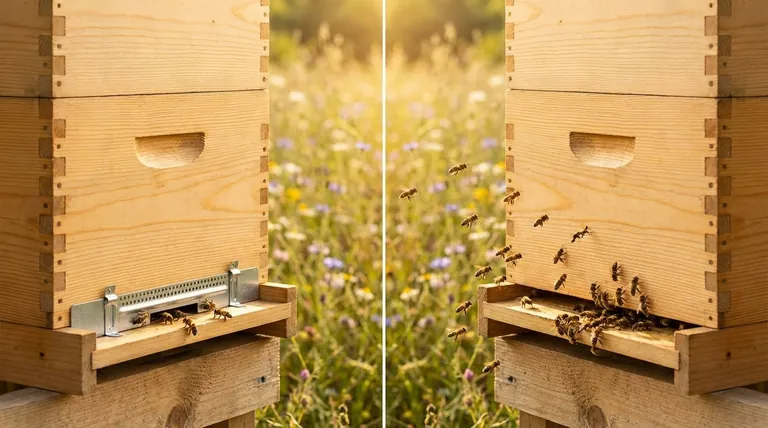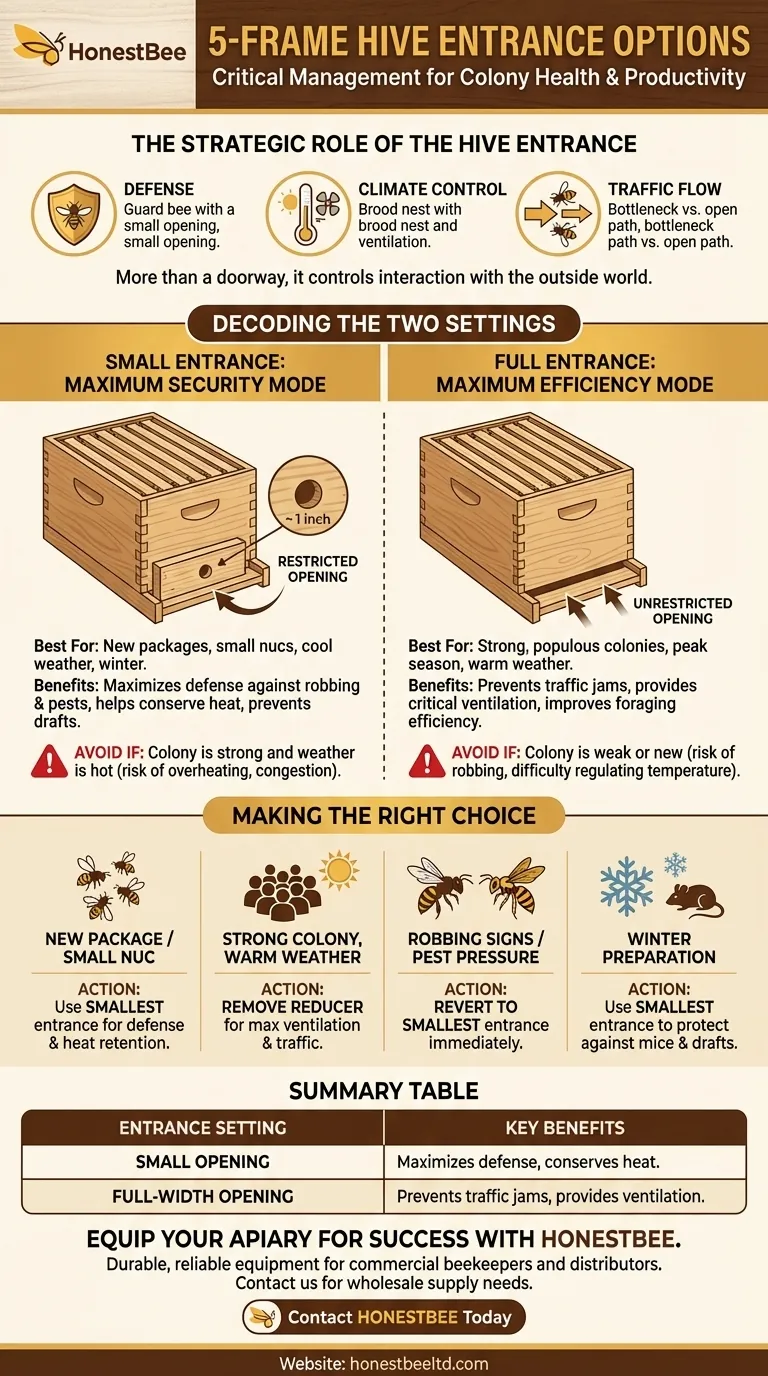For a standard 5-frame nucleus hive, you have two primary entrance configurations controlled by a wooden block called an entrance reducer. You can either use the small, pre-drilled opening for a restricted entrance, or you can remove the reducer entirely to provide the colony with a full-width, wide-open entrance. The choice is not arbitrary; it is a critical management decision that directly impacts your colony's ability to thrive.
The size of your hive entrance is not a static setting but a dynamic tool. The correct size depends entirely on your colony's strength, the time of year, and the presence of external threats, directly influencing its defense, ventilation, and temperature control.

The Strategic Role of the Hive Entrance
The entrance is more than just a doorway for bees. It is the single point of control for the colony's interaction with the outside world, serving three critical functions.
A Gateway for Defense
A smaller entrance is easier for the colony's guard bees to defend. This is crucial for preventing "robbing," where stronger hives attack a weaker one to steal its honey, often resulting in the collapse of the targeted colony.
A restricted entrance also helps the bees defend against pests like yellow jackets, wasps, and mice, which can otherwise overwhelm or inhabit a small hive.
A Regulator for Climate Control
Bees work tirelessly to maintain a stable temperature and humidity inside the hive, especially in the brood nest where larvae are raised.
A smaller entrance helps a young or small colony conserve heat during cool weather. Conversely, a larger entrance is vital for ventilation during hot weather, preventing the hive from overheating and allowing the bees to cure honey more efficiently.
A Funnel for Traffic
During a heavy nectar flow, thousands of forager bees will be coming and going. A restricted entrance can create a bottleneck, slowing down foraging operations and causing "bearding," where bees cluster on the outside of the hive.
An open entrance allows for maximum traffic flow, improving the colony's foraging efficiency during peak season.
Decoding the Two Entrance Settings
Your entrance reducer provides two simple but powerful options. Knowing when to use each one is fundamental to good beekeeping.
The Small Entrance: Maximum Security Mode
The small opening, typically around 3/4 inch to 1 inch wide, should be your default setting for any new or small colony.
Use this setting when you first install a package or nuc, as the colony's population is low and its defensive capabilities are limited. It provides the best protection against robbing and helps the small cluster of bees maintain warmth.
This setting is also essential in the fall and winter to protect against cold drafts and prevent mice from entering the hive to nest.
The Full Entrance: Maximum Efficiency Mode
Removing the entrance reducer completely gives the bees access to the full-width opening of the bottom board.
This setting is appropriate only for a strong, populous colony during the peak of the season (late spring and summer) when nectar is abundant and daytime temperatures are consistently warm. The large opening prevents traffic jams and provides critical ventilation to help cool the hive.
Understanding the Trade-offs
Choosing the wrong entrance size at the wrong time can create significant problems for your colony.
The Risk of an Entrance That's Too Small
If you leave the entrance reducer on its smallest setting when a colony has become powerful and the weather is hot, you risk several issues.
The colony may overheat, forcing bees to expend energy fanning instead of foraging. It also creates congestion that can slow nectar collection and contribute to swarming impulses as the bees feel overcrowded.
The Risk of an Entrance That's Too Large
Opening the entrance too wide, too early, is one of the most common and dangerous mistakes for a new beekeeper.
A large entrance on a weak colony is an open invitation for robbing bees, which can quickly destroy the hive. It also makes it much harder for the colony to regulate its internal temperature, forcing them to expend precious resources on heating the brood nest instead of expanding it.
Making the Right Choice for Your Colony
Your goal is to match the entrance size to the colony's current needs to provide the right balance of security and efficiency.
- If you have a new package or a small nuc: Use the smallest entrance setting to maximize defense and heat retention.
- If your colony is strong and filling the hive during warm weather: Remove the reducer entirely to maximize ventilation and foraging traffic.
- If you notice signs of robbing or heavy pest pressure: Immediately revert to the smallest entrance, regardless of colony size or season.
- If you are preparing the hive for winter: Use the smallest entrance to protect against mice and reduce cold drafts.
Properly managing the hive entrance is one of the most effective ways you can support your colony's health and productivity.
Summary Table:
| Entrance Setting | Best For | Key Benefits |
|---|---|---|
| Small Opening | New colonies, weak hives, cool weather, winter | Maximizes defense against robbing/pests, helps conserve heat. |
| Full-Width Opening | Strong colonies, peak season, warm weather | Prevents traffic jams, provides critical ventilation for cooling. |
Equip your apiary for success with HONESTBEE.
Managing your hive entrance is a fundamental skill for a thriving colony. As a commercial beekeeper or distributor, you need durable, reliable equipment that supports your strategic management decisions.
HONESTBEE supplies the high-quality beekeeping supplies and equipment that commercial apiaries and distributors depend on. Our wholesale-focused operations ensure you get the gear you need to protect your investment and maximize productivity.
Ready to strengthen your beekeeping operation? Contact HONESTBEE today to discuss your wholesale supply needs.
Visual Guide

Related Products
- Beehive Entrance Reducer Guardian Metal Hive Entrance for Bees
- Multi-Functional Sliding Hive Entrance for Beekeeping
- Multi-Functional Rotary Hive Entrance Disc for Beekeeping
- Professional Reversible Beehive Hive Entrance
- Beehive Entrance Discs Plastic Bee Entrance Disc for Bee Hives
People Also Ask
- How big should a beehive entrance be? Optimize for Colony Health & Honey Production
- What are the different types of entrance reducers available? A Guide to Protecting Your Hive
- What should be done after transferring frames to the new hive? Essential Steps for a Secure Colony
- What size is the entrance hole in a native bee hive? The 13mm Standard for a Thriving Colony
- What are the two functions of the Entrance Reducer? Master Hive Defense and Safe Transport



















